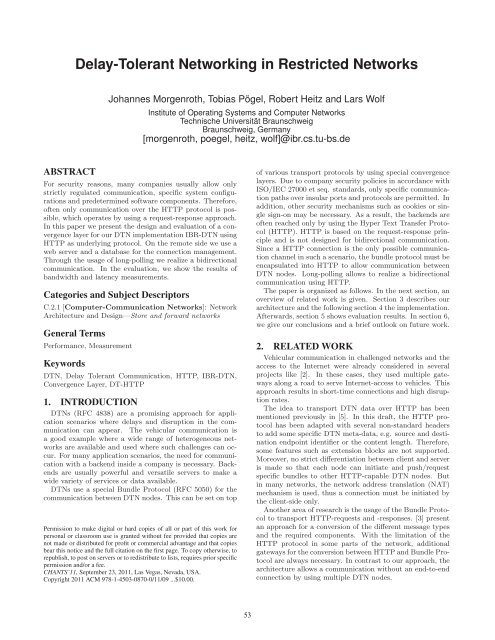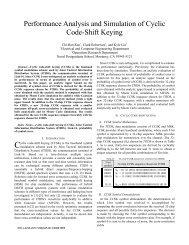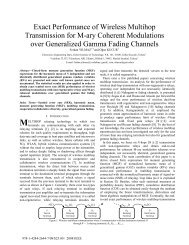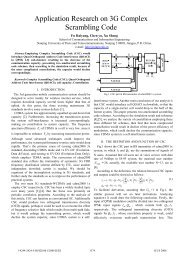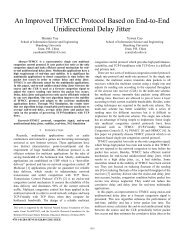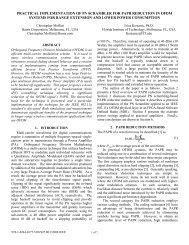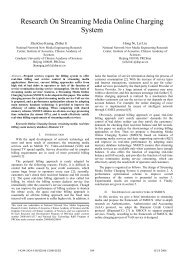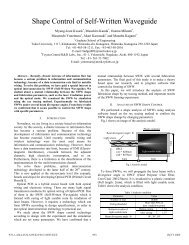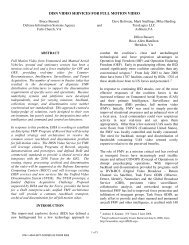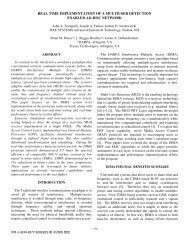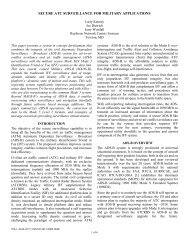Delay-Tolerant Networking in Restricted Networks
Delay-Tolerant Networking in Restricted Networks
Delay-Tolerant Networking in Restricted Networks
You also want an ePaper? Increase the reach of your titles
YUMPU automatically turns print PDFs into web optimized ePapers that Google loves.
ABSTRACT<br />
<strong>Delay</strong>-<strong>Tolerant</strong> <strong>Network<strong>in</strong>g</strong> <strong>in</strong> <strong>Restricted</strong> <strong>Networks</strong><br />
Johannes Morgenroth, Tobias Pögel, Robert Heitz and Lars Wolf<br />
For security reasons, many companies usually allow only<br />
strictly regulated communication, specific system configurations<br />
and predeterm<strong>in</strong>ed software components. Therefore,<br />
often only communication over the HTTP protocol is possible,<br />
which operates by us<strong>in</strong>g a request-response approach.<br />
In this paper we present the design and evaluation of a convergence<br />
layer for our DTN implementation IBR-DTN us<strong>in</strong>g<br />
HTTP as underly<strong>in</strong>g protocol. On the remote side we use a<br />
web server and a database for the connection management.<br />
Through the usage of long-poll<strong>in</strong>g we realize a bidirectional<br />
communication. In the evaluation, we show the results of<br />
bandwidth and latency measurements.<br />
Categories and Subject Descriptors<br />
C.2.1 [Computer-Communication <strong>Networks</strong>]: Network<br />
Architecture and Design—Store and forward networks<br />
General Terms<br />
Performance, Measurement<br />
Keywords<br />
DTN, <strong>Delay</strong> <strong>Tolerant</strong> Communication, HTTP, IBR-DTN,<br />
Convergence Layer, DT-HTTP<br />
1. INTRODUCTION<br />
DTNs (RFC 4838) are a promis<strong>in</strong>g approach for application<br />
scenarios where delays and disruption <strong>in</strong> the communication<br />
can appear. The vehicular communication is<br />
a good example where a wide range of heterogeneous networks<br />
are available and used where such challenges can occur.<br />
For many application scenarios, the need for communication<br />
with a backend <strong>in</strong>side a company is necessary. Backends<br />
are usually powerful and versatile servers to make a<br />
wide variety of services or data available.<br />
DTNs use a special Bundle Protocol (RFC 5050) for the<br />
communication between DTN nodes. This can be set on top<br />
Permission to make digital or hard copies of all or part of this work for<br />
personal or classroom use is granted without fee provided that copies are<br />
not made or distributed for profit or commercial advantage and that copies<br />
bear this notice and the full citation on the first page. To copy otherwise, to<br />
republish, to post on servers or to redistribute to lists, requires prior specific<br />
permission and/or a fee.<br />
CHANTS’11, September 23, 2011, Las Vegas, Nevada, USA.<br />
Copyright 2011 ACM 978-1-4503-0870-0/11/09 ...$10.00.<br />
Institute of Operat<strong>in</strong>g Systems and Computer <strong>Networks</strong><br />
Technische Universität Braunschweig<br />
Braunschweig, Germany<br />
[morgenroth, poegel, heitz, wolf]@ibr.cs.tu-bs.de<br />
53<br />
of various transport protocols by us<strong>in</strong>g special convergence<br />
layers. Due to company security policies <strong>in</strong> accordance with<br />
ISO/IEC 27000 et seq. standards, only specific communication<br />
paths over <strong>in</strong>sular ports and protocols are permitted. In<br />
addition, other security mechanisms such as cookies or s<strong>in</strong>gle<br />
sign-on may be necessary. As a result, the backends are<br />
often reached only by us<strong>in</strong>g the Hyper Text Transfer Protocol<br />
(HTTP). HTTP is based on the request-response pr<strong>in</strong>ciple<br />
and is not designed for bidirectional communication.<br />
S<strong>in</strong>ce a HTTP connection is the only possible communication<br />
channel <strong>in</strong> such a scenario, the bundle protocol must be<br />
encapsulated <strong>in</strong>to HTTP to allow communication between<br />
DTN nodes. Long-poll<strong>in</strong>g allows to realize a bidirectional<br />
communication us<strong>in</strong>g HTTP.<br />
The paper is organized as follows. In the next section, an<br />
overview of related work is given. Section 3 describes our<br />
architecture and the follow<strong>in</strong>g section 4 the implementation.<br />
Afterwards, section 5 shows evaluation results. In section 6,<br />
we give our conclusions and a brief outlook on future work.<br />
2. RELATED WORK<br />
Vehicular communication <strong>in</strong> challenged networks and the<br />
access to the Internet were already considered <strong>in</strong> several<br />
projects like [2]. In these cases, they used multiple gateways<br />
along a road to serve Internet-access to vehicles. This<br />
approach results <strong>in</strong> short-time connections and high disruption<br />
rates.<br />
The idea to transport DTN data over HTTP has been<br />
mentioned previously <strong>in</strong> [5]. In this draft, the HTTP protocol<br />
has been adapted with several non-standard headers<br />
to add some specific DTN meta-data, e.g. source and dest<strong>in</strong>ation<br />
endpo<strong>in</strong>t identifier or the content length. Therefore,<br />
some features such as extension blocks are not supported.<br />
Moreover, no strict differentiation between client and server<br />
is made so that each node can <strong>in</strong>itiate and push/request<br />
specific bundles to other HTTP-capable DTN nodes. But<br />
<strong>in</strong> many networks, the network address translation (NAT)<br />
mechanism is used, thus a connection must be <strong>in</strong>itiated by<br />
the client-side only.<br />
Another area of research is the usage of the Bundle Protocol<br />
to transport HTTP-requests and -responses. [3] present<br />
an approach for a conversion of the different message types<br />
and the required components. With the limitation of the<br />
HTTP protocol <strong>in</strong> some parts of the network, additional<br />
gateways for the conversion between HTTP and Bundle Protocol<br />
are always necessary. In contrast to our approach, the<br />
architecture allows a communication without an end-to-end<br />
connection by us<strong>in</strong>g multiple DTN nodes.
3. ARCHITECTURE<br />
This section presents our architecture for the <strong>in</strong>tegration<br />
of DTN nodes <strong>in</strong>side restricted networks where communication<br />
is only possible us<strong>in</strong>g the HTTP protocol. This is the<br />
case if the server is protected by a firewall that blocks all<br />
non-HTTP traffic. Thus, it is impossible to connect to it<br />
by us<strong>in</strong>g a TCP connection with a b<strong>in</strong>ary protocol like the<br />
bundle protocol. Another challenge are cellular and wireless<br />
local area networks, which are often equipped with a NAT<br />
mechanism. As a result, clients can not be reached directly<br />
from outside; <strong>in</strong>stead they have to <strong>in</strong>itiate each connection.<br />
Therefore, <strong>in</strong> our architecture the client will establish the<br />
connection to the server us<strong>in</strong>g HTTP.<br />
The architecture is subdivided <strong>in</strong>to two ma<strong>in</strong> components<br />
as depicted <strong>in</strong> figure 1. Due to the limitations of HTTP and<br />
the request-response pr<strong>in</strong>ciples, a server-client architecture<br />
is essential. On the server-side, a module is required to offer<br />
the necessary DTN functionality and a HTTP convergence<br />
layer to encapsulate DTN bundles <strong>in</strong>to HTTP. Additionally,<br />
a database is needed to store meta-data of stored bundles.<br />
In the follow<strong>in</strong>g we name this component server, becauseit<br />
do not <strong>in</strong>itiates any connection and just wait for <strong>in</strong>com<strong>in</strong>g<br />
HTTP connections from DTN clients. The client is suited<br />
with an additional HTTP convergence layer and performs<br />
GET and PUT calls to the server.<br />
3.1 Protocol<br />
Basically, HTTP is a request-response protocol. In this<br />
case, it is used to encapsulate a bidirectional communication<br />
betweenapublicserverandaclient. Aswithwebsockets[1],<br />
we use a mechanism called long-poll<strong>in</strong>g to set-up an HTTP<br />
connection for bidirectional communication, but place value<br />
on less complexity for the required implementation. In fact<br />
we use a pla<strong>in</strong> HTTP call, but the response is delayed as<br />
long as the server has no data to transmit. Furthermore, the<br />
connection stays open until it is <strong>in</strong>terrupted or a predef<strong>in</strong>ed<br />
timeout has elapsed.<br />
A GET request to a server is started with the common<br />
HTTP header and a URL conta<strong>in</strong><strong>in</strong>g the peer endpo<strong>in</strong>t identifiers<br />
(EID) of the request<strong>in</strong>g node as parameter. The latter<br />
is required for the rout<strong>in</strong>g module of the server, which<br />
has to choose the bundles to transfer. The server responds<br />
with the code ”200 OK”, sets the content type to multipart/mixed<br />
and the transfer-encod<strong>in</strong>g to chunked. Now, the<br />
downstream connection is established and ready to transfer<br />
bundles to the client. In front of each bundle, a chunked<br />
header is placed. It <strong>in</strong>cludes the size of the follow<strong>in</strong>g bundle<br />
and control flags for the HTTP connection. The bundle<br />
itself is b<strong>in</strong>ary encoded as def<strong>in</strong>ed <strong>in</strong> the bundle protocol<br />
specification RFC 5050.<br />
S<strong>in</strong>ce it is not possible to send multiple HTTP requests<br />
Apache Tomcat GET IBR-DTN<br />
Message<br />
Rout<strong>in</strong>g<br />
Filesystem<br />
Database<br />
DT-HTTP Servlet<br />
PUT<br />
HTTP CL<br />
Storage<br />
API<br />
Router<br />
Figure 1: Software architecture<br />
Application<br />
54<br />
<strong>in</strong> one connection asynchronously, a second connection is required<br />
to push bundles from the client to the server. Those<br />
bundles are encapsulated <strong>in</strong>to a standard HTTP PUT message<br />
which is acknowledged by the server <strong>in</strong> return. Accord<strong>in</strong>g<br />
to the previously def<strong>in</strong>ed PUT request, such a message<br />
conta<strong>in</strong>s the peer EID encoded as a parameter <strong>in</strong> the request<br />
URL.<br />
3.2 Client<br />
The client is designed as an additional module <strong>in</strong> a DTN<br />
daemon and shown <strong>in</strong> the simplified architecture (figure 1).<br />
Once the daemon is up, it tries to connect to a HTTP server.<br />
On a successful established connection, a GET request is sent<br />
to the server to poll await<strong>in</strong>g bundles for this node. If there<br />
are bundles available for the client, it receives them as a<br />
cont<strong>in</strong>uous stream of data, decode them on-the-fly and pass<br />
them to the <strong>in</strong>ternal process<strong>in</strong>g of the daemon.<br />
If the client has bundles to send, another HTTP connection<br />
is <strong>in</strong>itiated. Each bundle will be encapsulated <strong>in</strong>to an<br />
HTTP PUT request with the b<strong>in</strong>ary encoded bundle <strong>in</strong> the<br />
payload. Thereby, it is possible to transfer all extensions<br />
made to the orig<strong>in</strong>al bundle to the receiv<strong>in</strong>g client without<br />
be<strong>in</strong>g aware of them. F<strong>in</strong>ally, the server acknowledges the<br />
received bundle and closes the connection.<br />
3.3 Server<br />
The server consists of the servlet, a database, the rout<strong>in</strong>g<br />
module and a filesystem to store the b<strong>in</strong>ary bundles <strong>in</strong><br />
files. The tasks are to receive bundles from clients, store<br />
and forward them to other clients if they are connected. In<br />
addition, it has to consider priorities dur<strong>in</strong>g the delivery<br />
process (Message Rout<strong>in</strong>g) and delete expired bundles. If a<br />
client provides a bundle to store, the received data is saved<br />
<strong>in</strong>to files on the disk. These files are parsed to extract the<br />
meta-data of the bundle, which will be stored together with<br />
a reference to the file conta<strong>in</strong><strong>in</strong>g the stored bundle <strong>in</strong> the<br />
database.<br />
An <strong>in</strong>com<strong>in</strong>g HTTP GET call conta<strong>in</strong>s an identifier of the<br />
connect<strong>in</strong>g host encoded <strong>in</strong>to the request URL. This identifier<br />
is needed to determ<strong>in</strong>e bundles to transfer. Once the<br />
connection has been set-up, the thread calls the rout<strong>in</strong>g<br />
module to request a bundle to transfer. The rout<strong>in</strong>g module<br />
orders the bundles accord<strong>in</strong>g to their priority and rema<strong>in</strong><strong>in</strong>g<br />
lifetime before it returns an available bundle. If there is no<br />
bundle to be transferred, the thread goes <strong>in</strong>to a wait state<br />
and stays there until the network connection is disrupted or<br />
another thread notifies it about new available bundles.<br />
4. IMPLEMENTATION<br />
Due to security policies, software components and systems<br />
are typically predeterm<strong>in</strong>ed. For the provision of various services<br />
over HTTP, web servers typically exist and can be accessed<br />
from outside. In addition, these also have the advantage<br />
that they are designed for a potentially large number of<br />
connections. Therefore, we decided to use the flexible and<br />
scalable Apache Tomcat on the server side <strong>in</strong> conjunction<br />
with a PostgreSQL database which is used for the management<br />
of the <strong>in</strong>com<strong>in</strong>g and outgo<strong>in</strong>g DTN bundles. The encapsulation<br />
of the Bundle Protocol with<strong>in</strong> HTTP is realized<br />
with a developed servlet for Tomcat and is called DT-HTTP.<br />
To extract the meta-data of a received b<strong>in</strong>ary encoded bundle,<br />
a tool was written us<strong>in</strong>g the libraries provided by IBR-<br />
DTN. This tool reads the standard <strong>in</strong>put, parses the data
and returns the meta-data of the bundle, which is processed<br />
<strong>in</strong> subsequent.<br />
On the client side, we use our DTN implementation IBR-<br />
DTN [4] with an adapted and extended convergence layer<br />
which uses the HTTP protocol and does GET and PUT calls<br />
to the server. These are realized with the cURL library,<br />
which already supports many features relat<strong>in</strong>g to various<br />
security mechanisms (like SSL and cookies for s<strong>in</strong>gle-signon)<br />
and allows an easy adaptation to different requirements<br />
and environments.<br />
5. EVALUATION<br />
To prove the correctness and the performance of the implementation<br />
we did tests and measurements with regard to<br />
latency and throughput with the HTTP convergence layer.<br />
The servlet was deployed on a Tomcat 6, the current stable<br />
release of an open-source application server. As platform, a<br />
L<strong>in</strong>ux environment was used to run the Tomcat and a PostgreSQL<br />
8.3 database. All mach<strong>in</strong>es were connected by a fast<br />
Ethernet switch; thus the maximum reachable throughput<br />
is limited to 100 Mbit/s. All tests were done <strong>in</strong> a wired network<br />
to avoid <strong>in</strong>accuracy and disturbances as expected <strong>in</strong><br />
wireless networks.<br />
5.1 Latency<br />
In this case, we want to measure the latency of transmitted<br />
bundles and set-up two scenarios based on the three<br />
mach<strong>in</strong>es described above. The first scenario tests the client<br />
to server latency. With dtnp<strong>in</strong>g, a command l<strong>in</strong>e tool of<br />
IBR-DTN, a bundle is sent to the server, which is reflected<br />
by a build-<strong>in</strong> mechanism and sent back to the client. As second<br />
scenario we tested forward<strong>in</strong>g of bundles from client to<br />
another, us<strong>in</strong>g the server as <strong>in</strong>termediate node. Both tests<br />
are repeated 1000 times and dtnp<strong>in</strong>g measures the roundtrip<br />
time (RTT) of each transmission.<br />
round trip time (ms)<br />
700<br />
600<br />
500<br />
400<br />
300<br />
200<br />
100<br />
0<br />
client server<br />
client server client<br />
10 100 1000 10000 100000 1000000<br />
bundle payload size (byte)<br />
Figure 2: Average RTT and standard deviation<br />
The result of both scenarios are shown <strong>in</strong> figure 2. For<br />
both scenarios the RTT does not seem to be <strong>in</strong>fluenced by<br />
thepayloadsizeifitislowerthanorequalto100kb. This<br />
suggest that the process<strong>in</strong>g delay is more significant <strong>in</strong> those<br />
cases than the transmission delay. In this test, the pass with<br />
the very low payload size of 10 bytes got some outliers up to<br />
213.35 ms, which raises the average value to the same level<br />
as with 10 kbytes. We assume here a race condition between<br />
the thread receiv<strong>in</strong>g the bundle and the thread send<strong>in</strong>g the<br />
answer. This procedure is stable but rarely leads to a higher<br />
delay.<br />
To <strong>in</strong>vestigate the correlation of delay and payload size,<br />
we took a s<strong>in</strong>gle transmission of the delay test with an RTT<br />
55<br />
near the average of all transmissions with<strong>in</strong> the same payload<br />
size and traced it down with wireshark. We found out,<br />
that the significant part of the whole delay is the result of<br />
the server process<strong>in</strong>g. In case of forward<strong>in</strong>g bundles to another<br />
client the server needs ≈ 60 ms to process the received<br />
bundle. Furthermore, the delay is ≈ 115 ms if the server has<br />
to process the bundle to generates an echo, s<strong>in</strong>ce this is a<br />
more complex operation than just forward<strong>in</strong>g.<br />
5.2 Throughput<br />
Next we measured the maximum throughput. To do this,<br />
1000 bundles with a def<strong>in</strong>ed payload size are created by host1<br />
and forwarded to the server. Then, host2 is connected and<br />
receives the bundles from the server. The test has been repeated<br />
with six different payload sizes and we measured the<br />
maximum reachable throughput at 90.4 Mbit/s withiperf<br />
as reference. Dur<strong>in</strong>g the test, the whole network traffic was<br />
logged by wireshark to get the achieved throughput, bandwidth<br />
usage and protocol overhead.<br />
The result of max. 72.9 Mbit/s as downstream performance,<br />
the upstream is quite poor with max. 23.5 Mbit/s.<br />
This is due to the high process<strong>in</strong>g delay of the server for this<br />
manner. To get more details about this delay, we profiled<br />
the Tomcat servlet with the Netbeans Java Profiler. For<br />
each bundle the server receives, a new database connection<br />
is established. This delay slows down the whole process.<br />
Another reason for the high delay is the process<strong>in</strong>g of the<br />
<strong>in</strong>com<strong>in</strong>g bundle at the servlet. Each received bundle is<br />
stored as a file on the disk. Then, the servlet parses the<br />
bundle data to extract the meta-data, which is stored <strong>in</strong> the<br />
database afterwards. This store and parse mechanism delays<br />
the receiv<strong>in</strong>g procedure compared to the send<strong>in</strong>g procedure,<br />
which only copies files <strong>in</strong>to the HTTP stream.<br />
6. CONCLUSIONS<br />
In this paper we presented the design and implementation<br />
of an HTTP convergence layer by us<strong>in</strong>g the long-poll<strong>in</strong>g<br />
mechanism. This allows a communication between a DTN<br />
node and various web services. The present analysis already<br />
shows satisfactory results, tak<strong>in</strong>g <strong>in</strong>to account the limitations<br />
caused by the HTTP protocol.<br />
7. REFERENCES<br />
[1] I. Fette and A. Barth. The WebSocket protocol.<br />
Internet-Draft draft-abarth-thewebsocketprotocol-01,<br />
Internet Eng<strong>in</strong>eer<strong>in</strong>g Task Force, Jan. 2011. Work <strong>in</strong><br />
progress.<br />
[2] J. Ott and D. Kutscher. Why Seamless? Towards<br />
Exploit<strong>in</strong>g WLAN-Based Intermittent Connectivity on<br />
the Road. In <strong>in</strong> Proceed<strong>in</strong>gs of the TERENA<br />
<strong>Network<strong>in</strong>g</strong> Conference, TNC 2004, 2004.<br />
[3] L. Peltola. Enabl<strong>in</strong>g DTN-based Web Access: The<br />
Server Side. Master’s thesis, Hels<strong>in</strong>ky University of<br />
Technology, April 2008.<br />
[4] S.Schildt,J.Morgenroth,W.-B.Pöttner, and L. Wolf.<br />
IBR-DTN: A lightweight, modular and highly portable<br />
Bundle Protocol implementation. Electronic<br />
Communications of the EASST, 37:1–11, Jan 2011.<br />
[5] L. Wood and P. Holliday. Us<strong>in</strong>g HTTP for delivery <strong>in</strong><br />
<strong>Delay</strong>/Disruption-<strong>Tolerant</strong> <strong>Networks</strong>. Internet-Draft<br />
draft-wood-dtnrg-http-dtn-delivery-07, Internet<br />
Eng<strong>in</strong>eer<strong>in</strong>g Task Force, May 2011. Work <strong>in</strong> progress.


